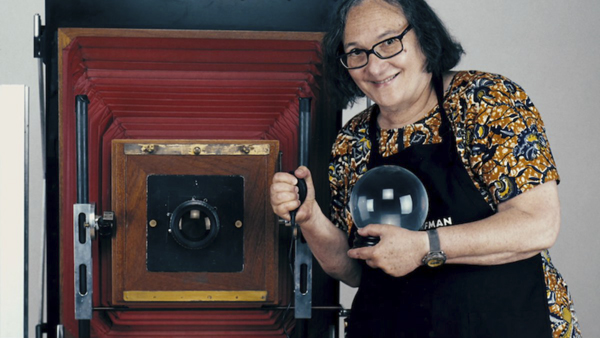In Errol Morris’s new documentary, photographer Elsa Dorfman talks a lot for a visual person, and the director, who usually hides behind a stationery camera, follows her around her studio with a lot of questions. Once he stops being fascinated by all the Famous Literary People she knew, whom she informally photographed over one year in New York City, the film becomes a lovely portrait of a haimish artist, a self-described “nice Jewish girl,” who is friendly and homey. Now at age 80, she faces the possible technological end of her favorite medium as the Polaroid 20-inch-by-24-inch photo becomes obsolete.
Dorfman’s accent points to her Boston-area roots, even without much early biographical details provided. Morris spends much screen time with many photos of her pivotal year in New York, when she worked as a secretary with Grove Press. He’s fascinated by the men she met, primarily the Beat Poets, including Lawrence Ferlinghetti, Gary Snyder, Gregory Corso, and Robert Creeley, with a special focus on her long friendship with Allen Ginsberg and Peter Orlovsky. (He does include her photos of feminist Andrea Dworkin and poet Audre Lorde.) She returned to her home turf to try out more conventional career and family options, but her supportive husband (civil rights lawyer Harvey Silverglate) encouraged her to pursue her true métier, portrait photography, and to even sell her work from a shopping cart in Harvard Square.
Her location in Cambridge proved fortuitous in gaining access to one of Polaroid’s few 20-inch-by-24-inch cameras—that founder Edwin Land personally designed—and the late corporation’s Artists Support Program. After her first subsidized series of Ginsberg and Orlovsky nudes in 1980 (that she’s delighted to pull out and show Morris), she first rented a camera that the company lent to the School of the Museum of Fine Arts, then managed to negotiate to become the only photographer to have one of these rare cameras in her own studio. Laughing now, she describes her nervousness of then plunging into the entrepreneurship of setting up a studio for commissioned portraits in 1981.
Morris doesn’t really acknowledge that she has photographed more women than men, nor does he see that she has continued a tradition of women studio photographers, from before Dorothea Lange and onward. The most charming centerpiece of the film is the montage of everyday people, and especially families, who hired her to commemorate special moments in their lives: parents’ special anniversaries; spouse’s birthdays, during illness or recovery; new babies, all accompanied by her anecdotes about their sittings. (She loves showing Morris her self-portraits over time with her husband and son, Isaac.)
For each patron, she insisted on only two exposures. While the clients invariably want the “perfect” take, she prefers the other one as “perfectly wonderful,” that she calls “B-Sides,” as in the other side of a hit 45 record. These are not “art” portraits à la Diane Arbus but populist appreciations of human beings, especially interacting family groups. She beams: “My role in the universe to make people feel better.” She even remembers her portraits of Ginsberg in terms of his visits coinciding with family events, like her son’s bar mitzvah.
This personal guided tour around her personal archive ranges from her earliest 2-¼-inch negatives to prints produced by Polaroid’s even larger-format, the 40-inch-by-80-inch instant camera. The impetus for this enjoyable, conversational documentary was her reluctant consideration of impending retirement and the archiving of her work while she finishes up the last of the 20-inch-by-24-inch film supply by the end of 2017. Yet there’s always talk of new techniques to try with film stock. She’s still optimistic that she can continue being analog in a digital world.







Leave A Comment